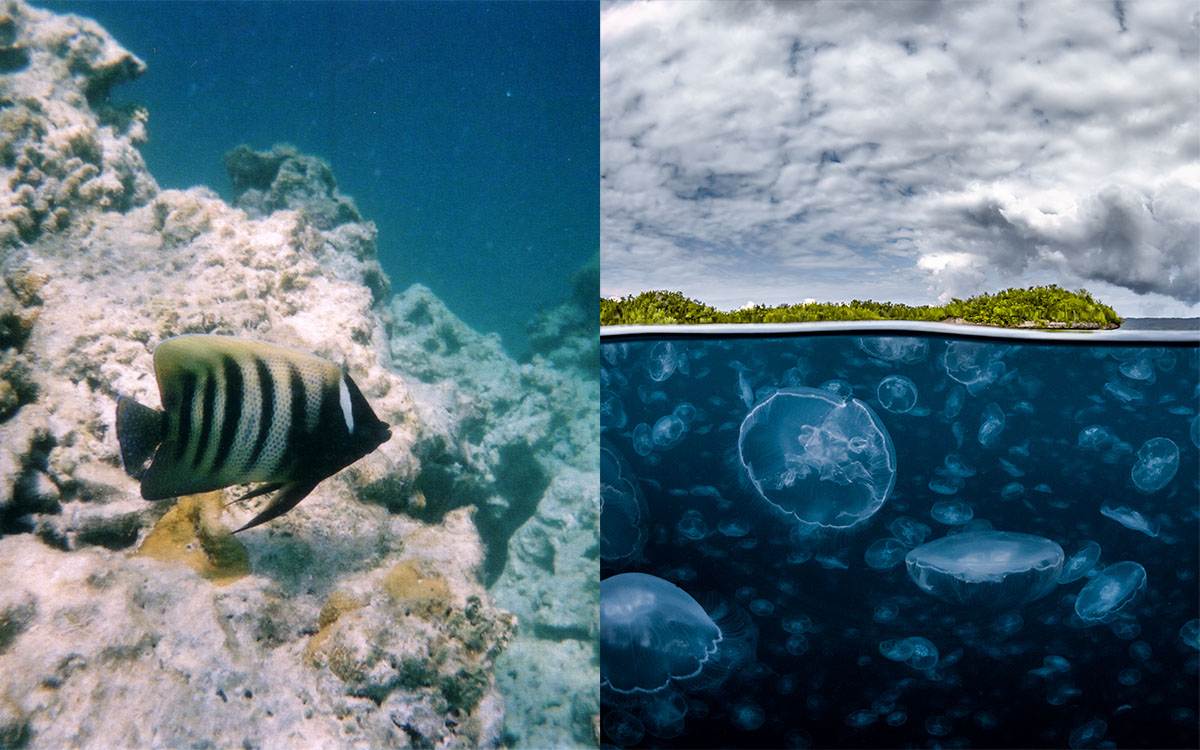Image credit: Jake Wilton
For a wannabe photographer (like me), there’s just as much beauty to be captured underwater as there is on dry land. The problem lies in learning the skills to do so.
Unfortunately for me – much like with astrophotography – underwater photography feels (at least so far) entirely beyond my capabilities. Take a look below at my best effort to date, which I took on a trip to the incredible Great Barrier Reef.
For emphasis, let’s compare it side-by-side with one from Jake Wilton – a Nikon Creator, ocean, nature and travel photographer, diver, and marine biologist with a deep-rooted passion for conservation.

Image credit: Left – Neil Fahey / Right – Jake Wilton
It’s okay… you’re allowed to laugh at it.
To be fair, the ocean is a relatively unchartered territory for me (at least compared to Jake). Mastering the art of underwater photography feels about as daunting as learning to draw in a room without light.
I’ve all but given up – and seeing my photo compared to Jake’s should probably be confirmation that I’ve made the right decision – but as a final reach, let’s see what he has to say to people like me about learning to photograph the underwater world and its creatures…
Diving right in: The most important skills for ocean photography
“Becoming comfortable and skilled in the water when either scuba or snorkelling is essential to photographing animals,” Jake emphasises. “When diving becomes second nature, it allows you to focus on your photography and earn better wildlife interactions.”
The choice between scuba or snorkel? That depends on the location and the marine spectacle you aim to capture. While scuba diving is an essential skill to have if you want to get serious about ocean photography, snorkelling will do the job for some shots. “Some places, like the Ningaloo Reef in Western Australia, are perfect for snorkelling,” he says.
Essential skills you may not have considered: Patience and respect
Jake notes, “You wouldn’t walk into a national park and chase after a kangaroo with your camera…”
Needless to say, that same respect for wildlife should extend beneath the waves.
If you’ve ever been on a snorkelling tour – like the one I took at the Great Barrier Reef – you’ll have seen people chasing schools of fish or sea turtles in the hope of getting the perfect shot.
Jake suggests you should instead be still and let the animal get comfortable with you. “It will yield better results for your photography and, more importantly, for the welfare of the animal.” Makes sense, really.
Knowledge is key: Research and understand your subject
Speaking of wildlife, Jake says the perfect shots don’t generally result from chance encounters.
“The best images are nearly always a result of time and planning,” he says. “Knowledge of an animal is key.”
Just as you’d plan a hiking trail, researching your subject’s behaviour, where they’re most likely to be found, and the right time of the year to get your shot is imperative.
The right gear for the job: Keep it real
Speaking of wildlife, Jake reckons the perfect shots don’t generally result from chance encounters.
“The best images are nearly always a result of time and planning,” he says. “Knowledge of an animal is key.”
Just as you’d plan a hiking trail, researching your subject’s behaviour, where they’re most likely to be found, and the right time of the year to get your shot is imperative.
Be present and have fun
Jake believes in enjoying the ocean’s essence first, photography second.
“Many people spend the whole time in the water looking from behind the camera, often missing out on experiencing what makes the ocean so special,” he says.
By being present in the moment, you’ll enrich your diving or snorkelling experience. That will shine through in your photos, giving them the best chance of feeling as natural and captivating as the experience itself.
It might be tempting to get lost in the quest for the perfect shot, but what Jake’s words speak to me is that the essence of this art form lies in the ability to immerse oneself in the moment. What I see in his photos is a genuine passion and respect for the ocean’s wild, untamed beauty.
As someone who lives in Victoria and is a little cold-averse, I probably still won’t aspire to reach anywhere near Jake’s level of ocean photography prowess. But there’s a flicker of hope that I might be able to catch at least one decent shot next time.
There’s a whole other universe under the ocean’s surface, brimming with colours and life, just waiting to be captured. Hopefully, Jake’s insights have inspired you to get down there and hone those photography skills. Who knows? You might one day find yourself not only capturing the shot you’ve always dreamed of, but also becoming an advocate for ocean conservation.
Have you tried your hand at ocean photography? Got any comments, corrections or suggestions? Let us know in the comments section below.
Exploring the Great Ocean Road?
You won’t see the best sights from your car. Get the definitive guidebook, featuring the 25 best walks in the area with detailed instructions and maps.






